As the Thea G. blew her horn, energy zipped through me as if I was seven years old. Being close to freighters has always given me a thrill! This aerial lift bridge at the Duluth-Superior Port had set my mind to wondering as Chuck and I observed freighters passing through. How had this engineering marvel been constructed? What’s the legend about entrepreneur, Wilhem Boeing, who had actually attempted to collect tolls from ships passing through the channel? Join Chuck and I as we visit the largest inland port and investigate the curiosities about this canal.
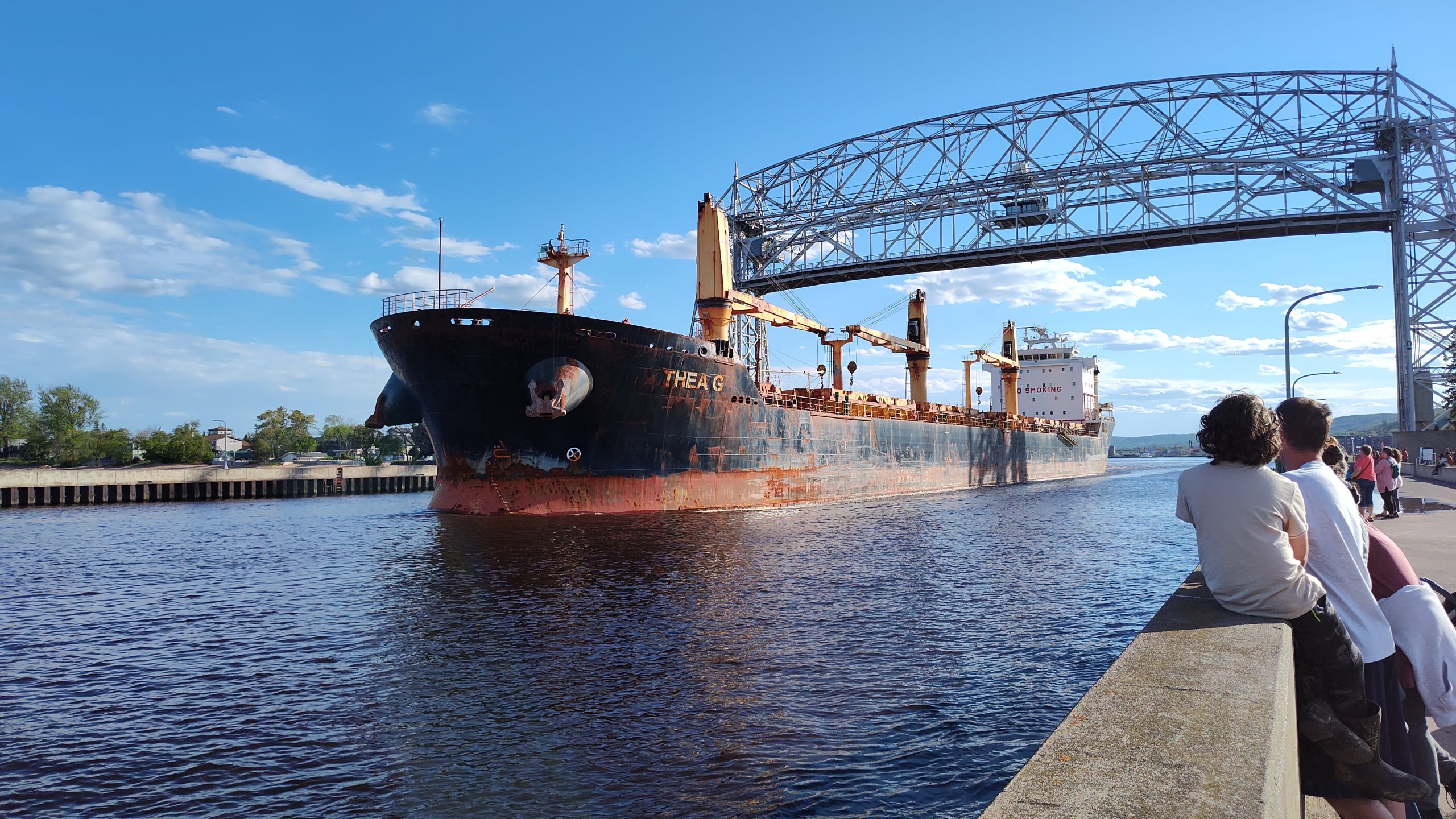
one long blast followed by two short.
Loaded with wheat she whispered over the water at the Duluth Canal.
Canal Construction
This fishing channel, which natives have called, “Ona non a in sing,” had needed an upgrade with the increase in rail and shipping traffic during the 1860’s. Lt. Col. W.F. Raynolds had recommended constructing a shipping lane through this “Minnesota Point” in 1866, rather than continuing to use the nearby port in Superior, Wisconsin.
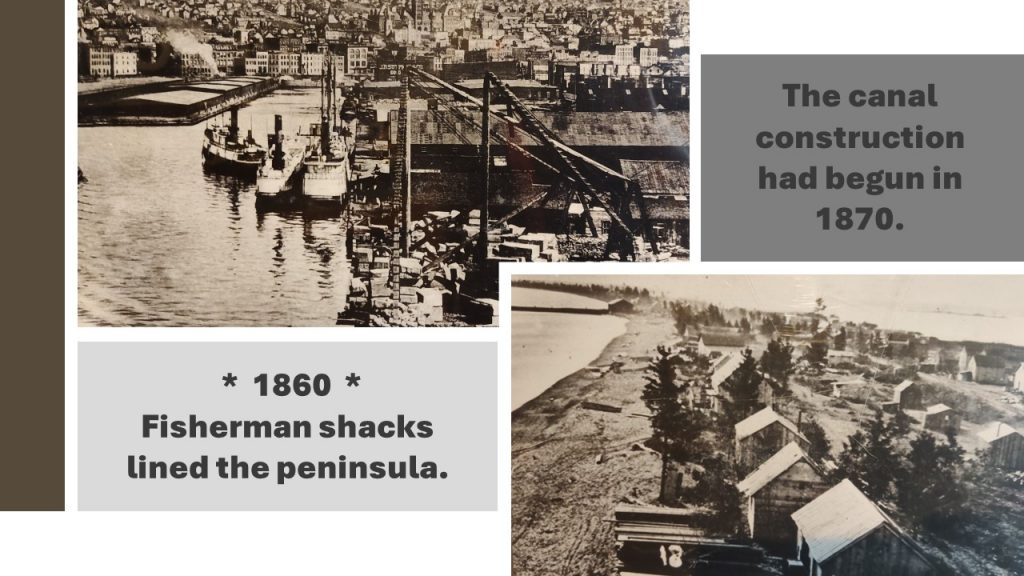
However, due to the cost, the government had been slow to act, so in 1870 the City of Duluth and the ‘Lake Superior and Mississippi Railroad Company’ had begun digging the canal themselves.
As the digging continued the Superior, Wisconsin politicians had filed for an injunction so this construction would cease. Their hope had been to secure the use of their own profitable port, not allowing this canal to be built. Well, they did finally obtain the court order on July 13, 1871. However, the Duluth Canal had already been completed two months earlier.
Legends have been shared about the spirited Duluthians completing this task in a timely manner. One tale tells how Sidney Luce, a local brewer who later became Duluth’s mayor, had joined the work crew on April 30, 1871. With a shovel he’d released the water creating the first connection between the bay and the Lake Superior.
Another story is how this Duluth canal had been built right through the middle of Wilhelm Boeing’s property. Wilhelm had quickly began concocting his own methods of making this channel profitable for himself.
Wilhelm Boing (Boeing)
Wilhelm Boing had sought the true American dream. When he had arrived in Detroit in 1868, following his service in the Austro-Prussian War, the 22 year old veteran began working as a laborer for Karl Ortmann. Wilhelm Boeing had Anglicized his last name by adding the letter “e.”
Boeing had built his fortune by purchasing 14 parcels of land on the “Minnesota Point” when they were priced cheaply during the “Panic of 1873.” These lots had flanked the inlet port with some lots being under water of the newly constructed shipping channel. Boeing had purchased other Minnesota acreage which had been located in the Mesabi Iron Range and timber land, which is now the town of Chisholm. From his Detroit home, Boeing had orchestrated the harvesting of timber and the mining of minerals. His fortune had grown exponentially.

While working for Karl Ortmann, Wilhelm had met Karl’s daughter, Marie. The two had courted as the elaborate home was being built.
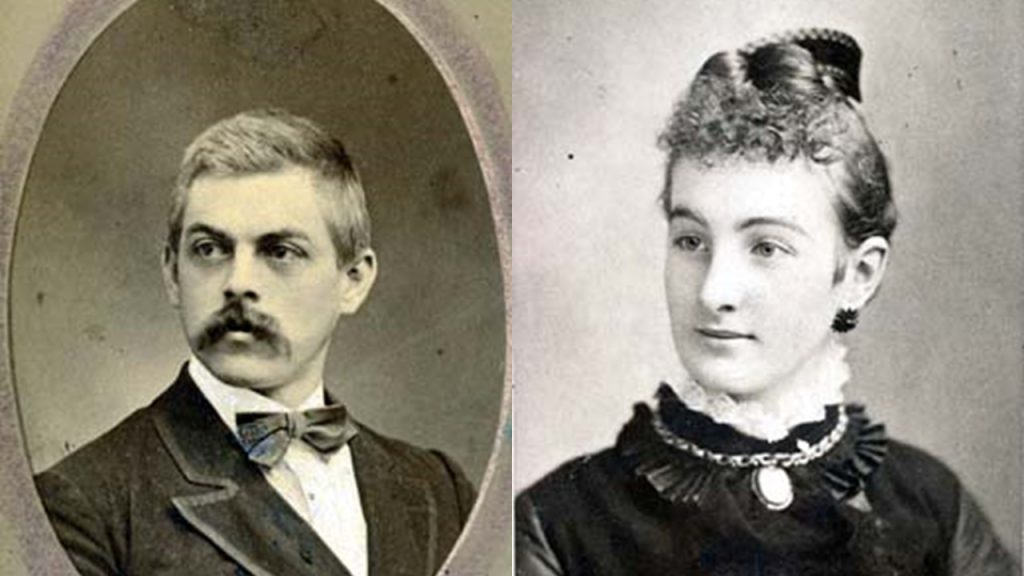
Wilhelm and Marie had welcomed two children into their family: William (founder of Boeing Aviation) and Caroline.
Boeing’s profits from the Minnesota timber and Mesabi minerals had provided plenty of money. Generously, the Boeings had donated funds for the first Detroit Museum of Art in 1883.
Charging Tolls
Here’s where this story gets interesting! So in the fall of 1889, capitalist-minded, Wilhelm Boeing, had decided that he could add to his earnings by offering to sell his parcels of “Minnesota Point” canal land to the City of Duluth for $100,000. The Duluth officials had scoffed at Boeing’s offer, so Boeing had strategized another plan, to charge tolls to vessels coming into the canal.
On September 27, 1889, Wilhelm had signed a warning notice that had appeared in Duluth newspapers. Fliers had also been distributed to shipping companies and to the vessels at the Sault Ste Marie locks if they had been heading toward Duluth. It read:
“You are hereby notified that on and after the 15th day of October 1889, the right of passage through the canal connecting the waters of Lake Superior and the Bay of Duluth will be denied by me to all boat and vessel owners. Those not paying would be proceeded against in the courts.”
St. Paul Daily Globe, a Duluth newspaper, had stated, “The general belief is that Mr. Boeing has valid title to the lots and that he will force the City of Duluth to pay the full claim for the valuable property taken without his consent and used for a long term of years.”
Wilhelm had set his mind to enforcing tolls since the City of Duluth had refused to purchase his 14 lots of the “Minnesota Point.” Boeing had notified his Minnesota attorney, Marshall H. Alworth, by telegraph to have a rope stretched across the canal and charge tolls to passing ships.
Attorney Alworth had then hired ferryman, Charles Winters, who had tasked his two assistants,
Frank Jacobs and James Jones, to secure a half-inch rope to the pilings on each side of the channel near the ferry.
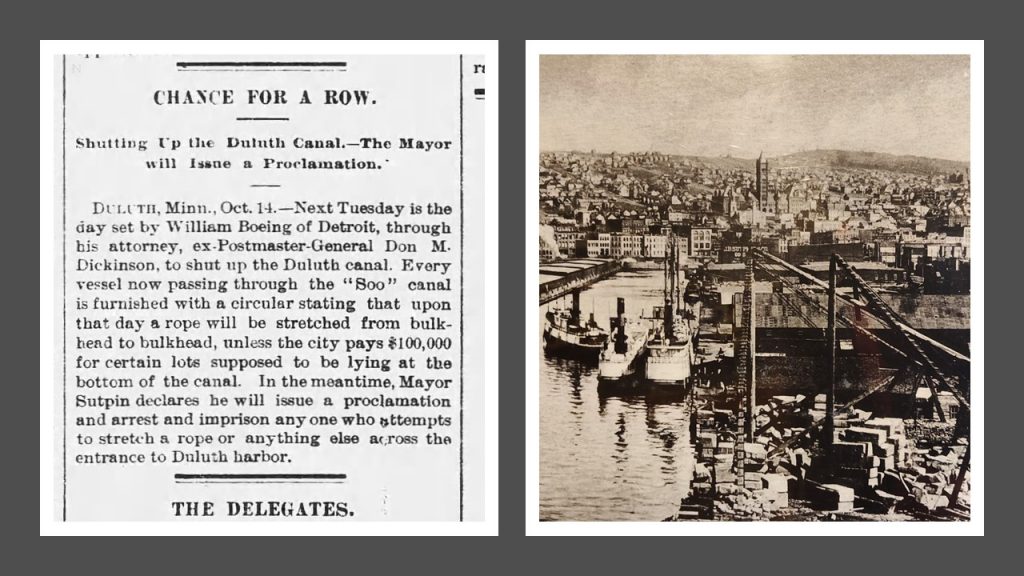
It had been reported that shortly after the rope had been strung on the morning of October 15th, 1889, that the Duluth police had cut the line in accordance to the Mayor’s Proclamation.
Once the police had left the scene, Frank Jacobs and James Jones had strung another rope across just as the Winslow had entered the channel. The captain of the ship had never stopped to pay the toll. He had continued forward, breaking the line with the bow of his vessel.
Jacobs and Jones had stretched a third rope across which had “brought to a standstill” the tug, Spirit, and the two scows it had been towing. Within moments of the snag, one of the Spirit crew members had sliced through the line and the vessels had continued on their way.
Armed with a chain the following day, Jacobs and Jones had planned to finally collect Boeing’s tolls. After all, a chain could not be cut easily. However, the chain hadn’t been secured properly along the sides of the canal, so it had released from its loose grip on the piling. This had been another failed attempt.
By this time the police force had been placed on “special patrol” at the canal beginning at 9:30 am. The Duluth Police Chief had ordered arrests of anyone who had tried to string a rope across the canal. This had put an end to the attempted toll collections.
Unresolved Land Dispute
The following May in 1890 at age 42, Wilhelm Boeing had died of influenza and this land dispute has remained unresolved. His 14 lots are now part of the canal itself, the piers and Canal Park. But there must be some retribution?
Through the articles I’ve read, the museum we’d visited and the videos I’ve watched, I have surmised that the federal jurisdiction over the canal had started as early as 1873 with the “River and Harbor Act.” This legislation “prohibits the unauthorized obstruction or alteration of any navigable water in the United States.” Then, in 1887 the Corps of Engineers had taken official control of the channel. So two years later, when Wilhelm Boeing had requested that The City of Duluth pay $100,000 for his 14 parcels on “Minnesota Point,” the town hadn’t even controlled the land. Boeing’s claims should have been directed to the federal government.
Bill Boeing
I had searched for the Boeing family’s retaliation, but only found that in 1903 Bill Boeing, Wilhelm’s son, had left Yale in his junior year. He had wanted to follow in his father’s footsteps, by amassing a fortune as a lumber baron in the Pacific northwest.
By 1916, Bill Boeing had started Aero Products Company building airplanes. Yes. That’s right. This had been the beginning of the world’s largest manufacturer of airplanes.
The Aerial Lift Bridge
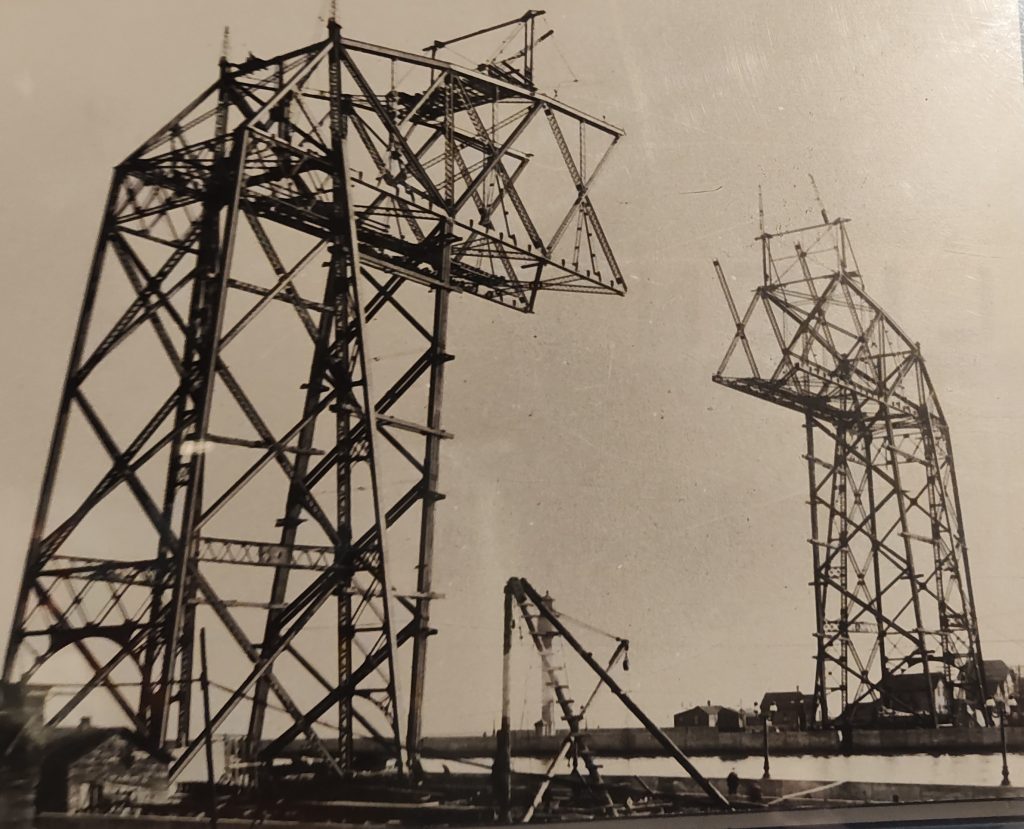
lift bridge constructed in 1901-1905 .
I’d been amazed to learn that in the beginning this bridge had a “gondola” that had spanned the canal giving carriages and people a one minute ride. This had been an improvement compared to the previous five minute ferry ride.
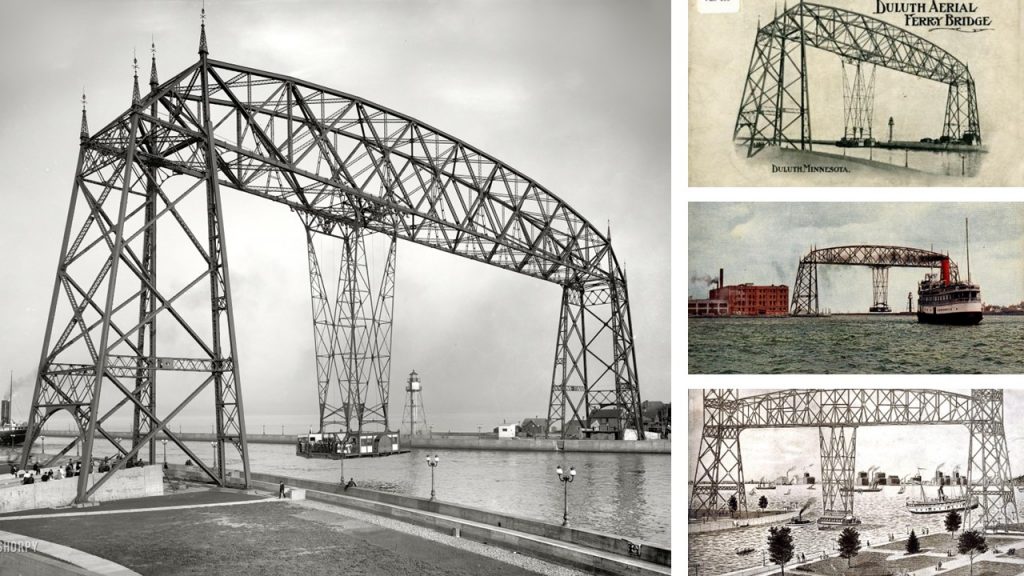
This gondola had a weight limit and hadn’t been designed for automobiles, so more modifications needed to be made in 1929. A roadway which could be lifted with counterweights had been constructed to the framework.
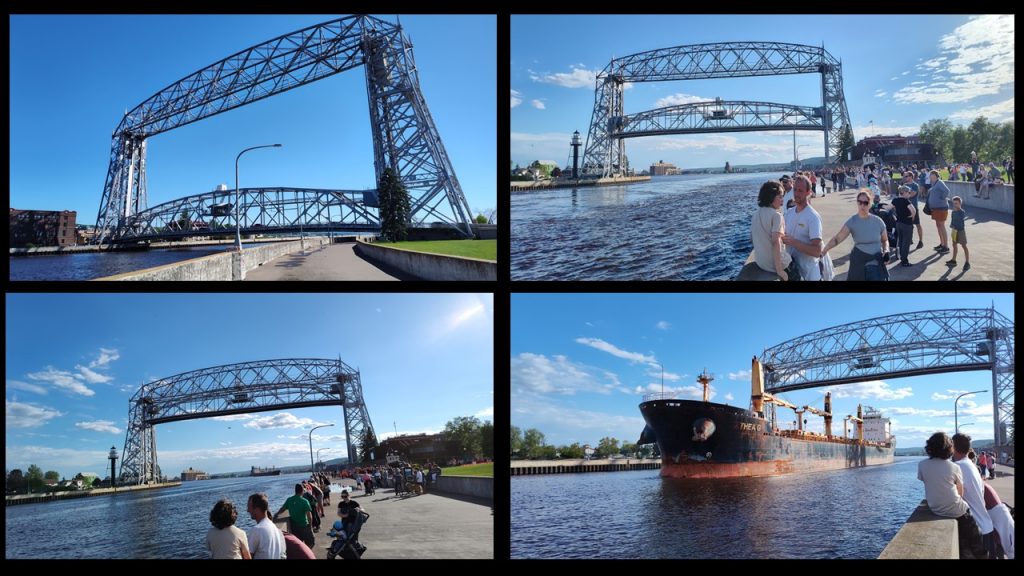
Ponderings
Peeking into the past solidifies connections of lives lived in pursuit of making a living and making this world a better place. The ebb and flow of economies has effected lives for centuries. Today the City of Duluth is vibrant with an active port, cultural foods, music and art.

Related Links:
Here’s our YouTube video visit of our trip to the Duluth Canal!
Restless Viking merchandise is now available!
Resources:
Archives of the Museum of Flight website
Newspapers Front Page article October 14, 1889
Northern Wilds Magazine article
Historical Detroit article
Wikipedia website
History Link website





